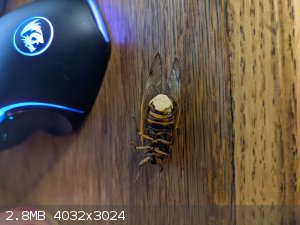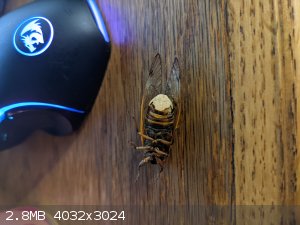njl
National Hazard
   
Posts: 609
Registered: 26-11-2019
Location: under the sycamore tree
Member Is Offline
Mood: ambivalent
|
|
Cicada fungi
I thought I would share some regional science here! Where I live, the famous 17 year brood X cicadas have returned in full force. A recent study found
that some cicadas were infected with the fungi Massospora cicadina which contains several psychoactive compounds, most notably cathinones and
tryptamines. The fungus destroys the cicadas reproductive systems and leaves behind a dry fungal mass containing the aforementioned compounds.
Paper
 
Reflux condenser?? I barely know her!
|
|
|
Opylation
Hazard to Others
  
Posts: 131
Registered: 30-8-2019
Member Is Offline
|
|
“What’s wrong? Fungus got your nethers?”
That’s super interesting though. I wonder if it’s a species of Cordyceps which are parasitic fungi that infect insects. Curious as to if you’ve
seen any fruiting bodies or if it’s just a fungal mat
[Edited on 3-6-2021 by Opylation]
|
|
|
karlos³
International Hazard
    
Posts: 1520
Registered: 10-1-2011
Location: yes!
Member Is Offline
Mood: oxazolidinic 8)
|
|
Whoah njl, thats pretty cool! 
Never heard or seen, or expected such a cool find... it sounds like contamination of their samples though, as we have seen already quite a few times
when such unlikely finds have occured 
From the cocaine and nicotine in egyptian mummies(which appears to be genuine, but was first ascribed to german egyptiologist smoking and snorting
coke during their research  ) to the african plant which was said to produce
tramadol.... but which later was found to only accumulate tramadol which cow herders feed their cattle for... for, whatever reason it might be(they
definitely took it too), and these bushes, a Nauclea species I believe, just accumulated it in its roots from the urine. ) to the african plant which was said to produce
tramadol.... but which later was found to only accumulate tramadol which cow herders feed their cattle for... for, whatever reason it might be(they
definitely took it too), and these bushes, a Nauclea species I believe, just accumulated it in its roots from the urine.
Not to mention the texan meth(and mescaline, and also DMT etc!) acacia, also a very curious case of possible contamination fragments in analytic
chemistry...
Or the very recent and surprising finding of both 2C-D and MMDA-2 in an indian medicinal plant(check symbooms thread, I posted the DOI in there).
Nonetheless very possible!
Just think of that crazy amazonian lichen which produces like, all the substituted analogues of DMT that occur in the plant world(bufotenin, psilocin,
DMT, 5-MeO DMT), which also looks psychedelically colourful(eat me, I make you high! seems to be its message?).
Or whatever else, for example, to mention the crazy sonoran desert toad, etc.
[Edited on 3-6-2021 by karlos³]
|
|
|
njl
National Hazard
   
Posts: 609
Registered: 26-11-2019
Location: under the sycamore tree
Member Is Offline
Mood: ambivalent
|
|
Karl, it could definitely be contamination. All I know is a few local news stations have run with it. If you take a look at their data, the indoles
are found in concentrations an order of magnitude lower than the cathinone, and I personally have a much easier time believing the presence of
cathinone over any indole, let alone structures as sensitive as psilocin.
Reflux condenser?? I barely know her!
|
|
|
karlos³
International Hazard
    
Posts: 1520
Registered: 10-1-2011
Location: yes!
Member Is Offline
Mood: oxazolidinic 8)
|
|
I actually find the cathinone more doubtful, due to its instability, and the fact that no other derivatives of it are present.
On the other hand, even very simple moulds are known to produce complex molecules like, some Aspergillus species who produce peptides of lysergic
acid.
And those are considerably more sensitive AND complex to biosynth than psilocin.
Really crazy stuff, thats for sure.
I am still very interested if those findings from the Phyllanthus species, containing 2C-D and MMDA-2, will turn out to contimation or not.
At least for those plants I have seen papers about their many bioactive compounds, and there were plenty with the correct aromatic core substitution
and a very close structure.
As for those things?
Definitely most interesting, but we'll see.
|
|
|
Opylation
Hazard to Others
  
Posts: 131
Registered: 30-8-2019
Member Is Offline
|
|
I believe psilocin when shielded from light and oxygen can last a relatively long time compared to when it is out in the open. As far as the stability
of psilocin in fresh mushroom bodies, apparently, when the flesh is damaged the organism releases two enzymes, one that rapidly dephosphorylates
psilocybin and another which rapidly oxidizes psilocin causing it to form dimers, trimers, and polymers which produce a blueish color. Psilocin in an
of itself, if protected from oxidation may be decently stable within an organism that does not have these enzymes. I spent a night looking into this a
while ago. This was the first article I looked at then looked up papers on the enzymes themselves but never recorded them. Below is a link to a short
little article, more written for the layman.
Source: https://www.nature.com/articles/d41586-019-03614-0
Idk, if the organism readily produces psilocin as a secondary metabolite with the absence of degredation enzymes it could be possible that it builds
up to an appreciable level.
[Edited on 4-6-2021 by Opylation]
|
|
|
zed
International Hazard
    
Posts: 2277
Registered: 6-9-2008
Location: Great State of Jefferson, City of Portland
Member Is Offline
Mood: Semi-repentant Sith Lord
|
|
Ummm.
Fungi, that produce psychedelics. Reminicent of the fungi that consume Wax Worms, meanwhile producing a huge yield of Lysergic Acid alkaloids.
Cicadas may also be vulnerable.
Oh, not that huge a yield. But, a hundred pounds of Wax Worms, would produce a very considerable yield of Lysergic Acid.
And somewhere, I have a reference. I'll go look for it.
https://www.ncbi.nlm.nih.gov/pmc/articles/PMC7357478/
OK, there's one. I might have some more references, but they are buried.
These fungi are getting a lot of attention right now. They might present a more attractive commercial route to obtaining Lysergic Acid Alkaloids.
[Edited on 4-6-2021 by zed]
|
|
|
Herr Haber
International Hazard
    
Posts: 1236
Registered: 29-1-2016
Member Is Offline
Mood: No Mood
|
|
The possibility of getting high on rotting insects genitals seems... thrilling.
Interesting contamination stories Karlos.
The spirit of adventure was upon me. Having nitric acid and copper, I had only to learn what the words 'act upon' meant. - Ira Remsen
|
|
|
njl
National Hazard
   
Posts: 609
Registered: 26-11-2019
Location: under the sycamore tree
Member Is Offline
Mood: ambivalent
|
|
Very cool paper Zed, it also happens to mention a different cicada fungi that yields some ergot derivatives.
Reflux condenser?? I barely know her!
|
|
|